|
24th February
My Garden, Hogganfield Loch and Cathkin Marsh
Still unable to drive due to my injured arm, my “cabin
fever” reached a peak by last Wednesday when I decided I must be
able to overcome my temporary disability and that I should at least try
to take some pictures. So I dug out my old monopod and attached it to
my Nikon D500 and sat at my back door ready to snap any birds that
visited the feeders I’d set up. The first customer was a jaunty
wee Robin. I held the monopod steady with the hand of my slinged-up
injured arm and took the photo using my left hand. It was slightly
painful, but bearable. A wee Dunnock was
next to wander in, foraging the ground below the feeders for spillages.
It wasn’t long before the House Sparrows showed up, emerging from
inside the large hedgerow that runs along the side of my garden. They
took turns raiding the seed feeder, resting between raids on my
trellis. The sun disappeared behind the clouds, and my scolding wife
showed up - so that was that.
| Robin |
Dunnock |
House Sparrow |
Female House Sparrow |
 |
 |
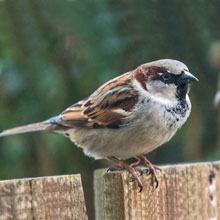 |
 |
Not discouraged by the experiences of the previous day, the next day I
managed to persuade my wife to drive me to Hogganfield Loch, Glasgow.
The light was nice for taking pictures so I got to work using camera on
monopod, but from a standing position. I was under strict instructions
to get what I could in 30 minutes, but such was the density of birds on
the Loch by the car park, I had accumulated over 80 shots in about 20
minutes. Dominating the feeding area were the Swans ,
mainly Mute Swans with a few Whoopers amongst them, and Mallards
(see “Pictures of the Week”, below). The
Whoopers’ head and neck feathers were tinged with brown. During
summer months the Whoopers were most likely resident in Iceland
where they feed in areas where the water is rich in Iron compounds.
These stain the feathers of the swans with a rust colour. During their
winter moults the stained feathers will be replaced. Weaving
precariously through the waters between the Swans, Tufted Ducks dived
for invertebrates running the wrong side of the moody Goldeneyes.
| Mute Swan |
Whooper Swan |
Tufted Duck |
Goldeneye |
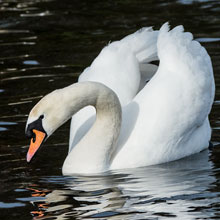 |
 |
 |
 |
Black-headed Gulls sat on the water awaiting their next feeding
opportunity as did the Goosanders, males and females now coming into
breeding plumages (also see “Pictures of the Week”,
below). I noticed a patch of Coltsfoot
was in early bloom due to the (as yet) mild winter. Satisfied that I was
up and running, if still somewhat limited to low and slow subjects, I
called it a day and headed home.
| Black - headed Gull |
Male Goosander |
Female Goosander |
Coltsfoot |
 |
 |
 |
 |
Next morning, Friday, I again sat inside my just-open back door, with
camera peeking through the gap and waited for some feathered action.
Soon the Hedge Sparrows became lively and they commuted between the
hedges and the feeders (also see “Pictures of the
Week”, below). A few young Starlings joined in. I spotted a
2nd-cycle Herring Gull on a rooftop some 50m away. A bit nearer, a pair
of Blue Tits seemed to be courting, but they may just have been
competing for territory.
| House Sparrow |
Starling |
2nd Cycle Herring Gull |
Blue Tit |
 |
 |
 |
 |
On another roof opposite my garden, a Magpie was using a TV aerial as a
perch, only to have its position usurped by a pair of crafty Jackdaws.
One of the pair kept flying off in a circle, returning seconds later -
could be more courtship behaviour. Just before lunch I finished my
morning session with a charming shot of a female House Sparrow.
On Sunday afternoon my wife once again was kind enough to run me to the SWT Reserve Cathkin Marsh,
near East Kilbride. Conditions were very pleasant. The weather was
unseasonably warm but the reserve was fairly quiet, as the panorama
below shows.
In one circuit of the reserve all I saw was a Carrion Crow, a Moorhen
and a pair of lively Great Tits (also see “Pictures of the
Week”, below). I noticed catkins on many young trees throughout the small reserve. I think they were Alder trees.
| Carrion Crow |
Alder |
Moorhen |
Great Tit |
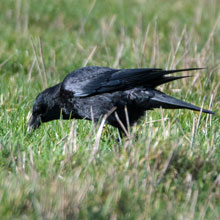 |
 |
 |
 |
It was pleasing to get back behind a camera again. Hopefully my arm
will have continued to improve next week, sufficiently enough to allow me
to get behind the driving wheel again. Fingers crossed.
Pictures of the Week:
| Goosander |
Mallard |
 |
 |
| Whooper Swan |
House Sparrow |
 |
 |
| Female House Sparrow |
Great Tit |
 |
 |
Birdwatching around Strathclyde Loch (Winter), Motherwell. 2019
There was no trip again this week since I’m still recovering from
an arm injury and I still can’t drive or hold a large camera.
Rather than let a week pass without a blog, and since I’m still
able to use my index finger to operate a keyboard, I’ve prepared
this short guide to winter birdwatching in Strathclyde Park .
When asked of birds at Strathclyde Park, most Park visitors could tell
you that there are swans, ducks and geese but few of them realise that
the list of birds is much more extensive than this. Indeed many will be
surprised that the pictures shown are all taken from the most used path
around the Loch (Please refer to the link here
for a map of the Park. I’ll be following the blue route starting
with the Motherwell-side of the orange route). Although they have been
accumulated over the last 4 years, the majority of these can be seen
any day of the week.
The main entrance of the Park is off Hamilton Road, Motherwell. The
landscape there is very familiar to me as I well remember as a
schoolboy fishing at the old Clyde Park Boating Pond before it was
incorporated, a decade later, into the south end of Strathclyde Country
Park. The trees that surround the children’s playground is rich
with bird life, as can be heard from the familiar loud calls of
squabbling Magpies to the more subtle and quiet whistles of Bullfinches.
On the grassy slopes, that were once a pitch and put course,
you’ll often see large flocks of grazing Greylag Geese.
In winter, amongst the leaf litter, you might catch some very skittish
Redwings as they search for insects, worms and even berries. These are
winter visitors from mainly Scandinavia.
| Magpie |
Bullfinch |
Greylag Goose |
Redwing |
 |
 |
 |
 |
Cousins of the Redwings that also winter here are Fieldfares. Handsome
and just as flighty, they have a similar diet to their Redwing
companions. Another member of the Thrush family
, the Mistle Thrush, is resident in the UK all year round. Like their
cousins, they too feed on invertebrates and berries. Two very well
known and popular birds present in the trees and bushes are Robins and
Blue Tits. Both will tolerate modest human attention, indeed Robins
often follow walkers almost begging food.
| Fieldfare |
Mistle Thrush |
Robin |
Blue Tit |
 |
 |
 |
 |
Probably the first wild flower of the year to blossom is the Snowdrop .
It’s scientific name is Gallanthus from the Greek meaning
“milk flower” since the flower resembles 3 drops of milk
hanging on the green stem (see “Pictures of the Week”,
below). You may see and hear Blackbirds rifling through the leaves and
flowers at the base of trees. If you look very carefully at the trunks
of the trees, and maybe listen for a high ring-tone-like chirps, you
may come across a little bird that is a bit smaller than a sparrow, the
Treecreeper .
They behave as their name suggests, by creeping up trees and branches
in search of small invertebrates. Also heard in the trees are the
“teecha-teecha” calls of the Great Tit. They are easily
identified by the black vertical stripe on their yellow breasts.
Occasionally you might also see a Grey Squirrel leaping between the branches.
| Blackbird |
Treecreeper |
Great Tit |
Grey Squirrel |
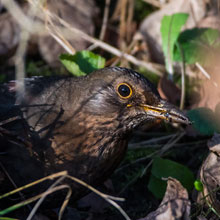 |
 |
 |
 |
The southern shores of the Loch is just short walk north of the play
area. It is an easier place to see birds. The most common birds are
gulls, mainly Black-headed and Herring Gulls, but rarer birds often
appear, such as the Ring-billed and Iceland gulls.
| Black - headed Gull |
Herring Gull |
Iceland Gull |
Ring - billed Gull |
 |
 |
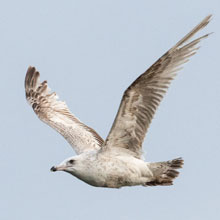 |
 |
The southwest area of the Loch is rich in birdlife and includes the
Pavilion and Southern Tower, along the lochside path and past car parks
1-4. Mischievous Jackdaws
are very common. They are very mobile opportunist thieves, always on
the lookout for a quick steal from other birds or unsuspecting humans.
Along the waters’ edge, Mallards and Mute Swans predominate.
There are usually a few Goosanders fishing further off the shore.
Occasionally one will bring its catch to the surface. A very exciting
sight but one that is surpassed by another species. There is an ever
increasing flock of Cormorants in the Loch, 100+ according to some.
These birds hunt in huge groups by moving along the middle of the Loch,
diving in unison and often rising to the surface with fish. The group is
usually accompanied by Gulls hoping to snatch their quarry.
| Jackdaw |
Female Mallard |
Goosander |
Cormorant |
 |
 |
 |
 |
From time to time, Pied Wagtails flit along the pebble banks seeking
insects. There are a couple of other Wagtail species that frequent the
Park, the White and Grey Wagtails. The Grey Wagtail is easily identified
by its yellow rump and underside, but distinguishing Pied from White
can be tricky.
Around car park 4, where car drivers can park at the water’s edge
and easily feed the birds, an accumulation of birds is usually found
there. A puzzle to me is that there are Tufted Ducks there (and in
similar sites in other parks) even although they are not attracted to
bread. They are diving ducks that eat invertebrates. Perhaps they like
the protective company of so many other birds.
| White Wagtail |
Grey Wagtail |
Pied Wagtail |
Tufted Duck |
 |
 |
 |
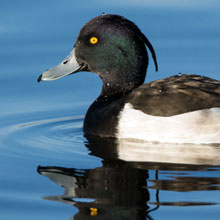 |
Earlier I said that the most common birds on the Loch are Gulls, but
the most prominent birds are probably Mute Swans. There are certainly
over 100 Swans on the Loch (but I’ve never seen any Whoopers
there) and they are certainly a crowd favourite that give a lot of
pleasure to a lot of folk who travel a long way to feed them. The
second most prominent birds are probably the Geese. These are mainly
Greylags, whose population has grown in recent years, and who can be
found in any area around the Loch. A few other geese species are
amongst them, including the white Embden Goose and hybrids such as a
Greylag-Swan Goose cross. Before turning my attention to the north end
of the Loch, and as an example of the infrequent sightings one can see
in the Park,
I’d like to mention a Kittiwake that turned up three years ago. Kittiwakes
are small gulls almost always seen by the coast or at sea. When they
appear at inland sites there is usually something amiss. This was the
case as sadly it died within a couple of days.
| Mute Swan |
Embden Goose |
Greylag x Swan Goose |
Kittiwake |
 |
 |
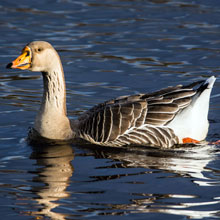 |
 |
The north end of the Loch, including the water sports starting area,
mote and surrounding trees is a rewarding area to investigate. It is
the site of the Bothwellhaugh mining village,
now completely gone, submerged beneath the waters of the Loch. Lapwings
(and their cousins the Golden Plovers) like to roost on the starting
bays. A couple of years ago I captured an image of a wee Goldcrest in
the bushes behind the tower. Also there I often see Long-tailed Tit
flocks, and recently there has been a large flock of Siskins in feeding
and on the trees. They make fascinating viewing but they are
under-appreciated as few walkers even notice their presence. The water
channel around the starting area is a favourite haunt of the Grey
Heron, as well as for Coots (see “Pictures of the Week”,
below), Moorhens and Little Grebes.
| Lapwing |
Goldcrest |
Siskin |
Grey Heron |
 |
 |
 |
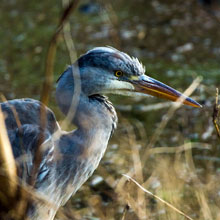 |
Another area worthy of a visit is around the mouth of the South Calder Water. The site contains Roman
archeology. An impressive Roman Bathhouse is certainly worth seeing but
the Roman Fort just up the hill from there is unimpressively
un-excavated. Birds seen on the water include Goldeneye, Scaup and
Little Grebes. In the trees you can find a large population of Carrion
Crows, another very common bird throughout the Park. It is also a good
place to see Buzzards as one often perches on the trees at the back of
the marsh that nestled below the site of the Roman Fort. And if you are
lucky you may catch sight of a Red Fox (see “Pictures of the
Week”, below). Siskins and Goldfinches are common there too.
| Goldeneye |
Scaup |
Little Grebe |
Goldfinch |
 |
 |
 |
 |
If you are walking around the Loch in Strathclyde Park I hope you will
look out for the many birds I have listed above. Please note that there
are other areas of the Park that I’ve not covered (subject of a
future blog maybe). Please refer to the Park map (referred to in the
first paragraph).
Pictures of the Week:
| Common Snowdrop |
Long - tailed Tit |
 |
 |
| Common Buzzard |
Coot |
 |
 |
| Red Fox |
Carrion Crow |
 |
 |
6th February 2019:
Kilspindie (Aberlady) and Musselburgh.
There was no Sunday trip this week due to an unfortunate accident I had
that left me with an injured arm and temporarily unable to drive or
hold my big camera. So I’ve decided to report on a trip I made on
the previous Wednesday. Regular followers of our blogs will recall my
failed attempts in December 2018 to locate the pair of Shore Larks at
Kilspindie, Aberlady. I had read in Twitter that they were still there,
so I determined that I should have another attempt to see them (I
should mention that, in the interim, I had at least half a dozen
unsuccessful tries).
Kilspindie (Aberlady):
It was a bright, sunny morning as I parked in the Kilspindie Golf Club
overflow car park. The birds had been sited very close to there but they
had been moving between the shore and the far end of the golf course.
So it was with an air of negativity I plodded onto the sandy shore and
began my search. All I could see initially were a Redshank and a pair
of Mallards. I soon met a fellow birder who was sitting with a spotting
scope. I asked him, “Any sign of the Shore Larks ?”
. “Yes, there they are there”, he answered with obvious
delight. And so they were, working their way across the sparse
vegetation in the sandy area adjacent to the car park. I managed a few
shots before they took off over the golf course, spooked by some noisy
golfers.
With the tide at its lowest and the sea and associated birds over half
a mile away I decided to relocate west to Musselburgh. As I drove out
of the car park I noticed that there were House Sparrows in the bushes.
With them were a few Tree Sparrows .
As I left the Kilspindie Golf club approach road there was a Curlew
feeding in the grassy triangle. I snapped a quick shot from the car
before leaving Aberlady heading for Musselburgh.
| House Sparrow |
Tree Sparrow |
Curlew |
Common Gull |
 |
 |
 |
 |
Musselburgh:
I parked on Goose Green Place by the mouth of the River Esk. I could
see there was a rain shower looming on the Pentland Hills. The sun was
shining though, so I ventured forth along the Esk mouth and took some
close shots of the birds that were feeding on the east bank. These were
mainly Redshanks and Wigeon
but a lot of Turnstones were flying in from areas being reclaimed by the
incoming tide. (See also “Pictures of the Week”.)
| Redshank |
Drake Wigeon |
Female Wigeon |
Turnstone |
 |
 |
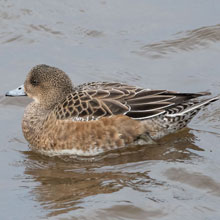 |
 |
As the inevitable rain moved in I rushed back to the car for shelter.
The shower pelted the car as I sat cozily inside sipping tea. When it
had passed I re-emerged from the car and was treated to the beautiful
sight of a wonderful rainbow over the Cadet halls.
I set off along the sea wall, scanning the shore for anything of interest. My first capture was of a Little Grebe
searching the Esk for little fish. The rainbow was moving out over the
Firth of Forth, inspiring me to photograph a Carrion Crow with a
spectral background. Goldeneye
were flying back from the sea, in up the Esk to shelter in much calmer
surroundings. A juvenile male passed close to the sea wall allowing me
to get quite a nice flight shot. The birds I expected to see at the edge
of the sea were not there. The strong winds had probably moved them on.
I decided to drive a mile east to the Levenhall Links where I could
visit the Scrapes and maybe see sheltering birds. Just as I returned to
the car I grabbed some shots of a bold Carrion Crow sitting on a fence.
| Little Grebe |
Carrion Crow |
Juvenile Male Goldeneye |
Carrion Crow |
 |
 |
 |
 |
As I scanned the sea at Levenhall Links it was still wild and very choppy. I moved into the RSPB Nature Reserve to the middle hide where I found Teal
close to the hide. There was a big flock of Bar-tailed Godwits resting
beside a huge flock of Oystercatchers. Also in good numbers were Lapwings.
Flighty at the best times they seemed very edgy, taking to the air at
the slightest threat. Perhaps a raptor was about. (See also
“Pictures of the Week”). A solitary Magpie was wandering
the grass in front of the hide, probing every now and again searching
for invertebrates.
| Teal |
Bar - tailed Godwit |
Lapwing |
Magpie |
 |
 |
 |
 |
The Oystercatchers were also restless and squabbling, but not so the
Redshanks. Things settled down after a bit - until a large flock of
Wigeon appeared on the scene. They circled the reserve several times
before flying east.
| Oystercatcher |
Redshank |
Bar - tailed Godwit |
Wigeon |
 |
 |
 |
 |
As I retraced my steps back to the car I met a bold wee Meadow Pipit flitting along the sea wall. In the distance I could see a Kestrel
hovering in the air, hunting small rodents. I realised then what was
worrying the Lapwings. I hoped to get closer as I neared my car.
Meanwhile I spotted a drake Long-tailed Duck
bobbing 50m off the sea wall. It wasn’t diving and the sun was
shining so I managed a decent record shot. I carefully tracked the
movements of the male Kestrel and I got lots of pictures of it as it
hung in the breeze. (See also “Pictures of the Week”).
It had been a successful day’s nature watching. I had finally
caught up with the elusive Kilspindie Shore Larks and Musselburgh, as
usual, offered up a feast of photographic delights.
Pictures of the Week:
| Turnstone |
Redshank |
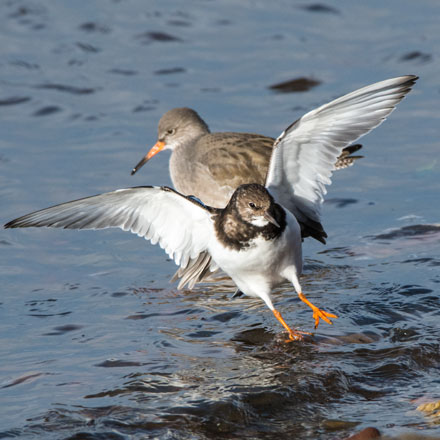 |
 |
| Lapwing |
Kestrel |
 |
 |
2nd February 2019:
Hogganfield Loch, Glasgow
It was a solo trip for me this week as John had a big family birthday
to see to. Also, I noticed that the weather for Sunday was to be
miserable so since Saturday was very sunny, although cold, I decided to
cancel the Sunday outing and go on Saturday instead. I made for
Hogganfield Park, a personal favourite of mine (No cooked breakfast this
week just a bowl of cornflakes and a banana).
One of the “Seven Lochs” , Hogganfield Park is shining example of Glasgow City Council’s commitment to supporting the environment. The Park was created in the 1920s and incorporated a tearoom and boating facilities . The loch and its surrounding woodlands, marsh and grasslands were declared a Local Nature Reserve in 1998. It was a winter’s scene when I arrived at Hoggie, with most of
the Loch frozen. Only the section by the car park was ice free, due to
the hundreds of birds crammed in there. Very kind and caring humans
regularly feed them so it was worth their while hanging about in the
area of the car park.
I set out capturing some images of the many birds there, starting with
a bird that birdwatchers rarely get close to in “wilder”
locations, the Goosander
(also see “Pictures of the Week 1”, below). Of course there
were Mallards, some skating over the icy shelves. Next I captured
images of Whooper Swans, regular winter visitors to the park and easily
distinguished
from the more common Mute Swans by their yellow bills and by their
noisy honks (also see “Pictures of the Week 1”, below). A
large flock of Feral Pigeons are permanent residents of the Loch
throughout the year. The white plumage of a Piebald Feral Pigeon caught
my eye as it scurried across the snow chasing the breadcrumbs.
| Goosander |
Mallard |
Whooper Swan |
Piebald Feral Pigeon |
 |
 |
 |
 |
Because the bird population of the Loch was crammed into such a small
space the birds were understandably on edge. The feisty Coot was extra
belligerent, threatening any birds that came close. The Tufted Ducks
were pretty wary between dives. Even the few Goldeneye I could see
seemed a bit anxious as they tried to feed (also see “Pictures of
the Week 1”, below). This was another bird that had become
accustomed to park life while in most other locations they are very
hard to approach. I decided to trek around the Loch to check out the
quieter east end of the park, between the Loch and Avenue End Road. On
the way there I came across a pair of Moorhens on the grassy banks of
the Loch.
| Coot |
Tufted Duck |
Female Goldeneye |
Moorhen |
 |
 |
 |
 |
Pictures of the Week1:
| Female Goosander |
Mute Swan |
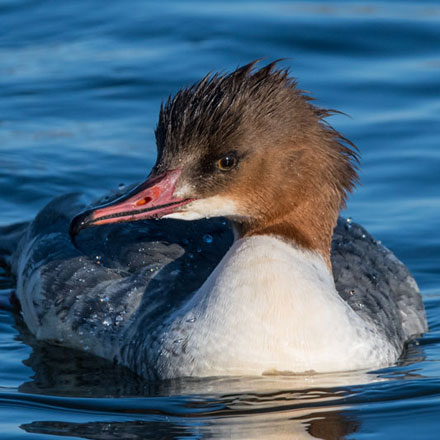 |
 |
| Coot |
Goldeneye |
 |
 |
It was a Arctic scene before me at the east end of the Park. The wee
pond, there, was of course, frozen over and seemed devoid of wildlife.
My expectations were raised when I spotted a Kestrel
sitting atop a small Silver Birch tree, and to my amazement it actually
flew towards me, settling on tree some 20m away. Then, a short time
after, a Red Fox
prowled by the west end of the pond. I think it heard the click of my
camera as it shifted at pace when I started shooting. I next moved out
of the Park briefly onto an old road that would take me to the footpath
on the other side of the pond. As I walked along the old road I saw
several small birds, including a Robin and a family of Bullfinches (see
also “Pictures of the Week 2”, below for more shots of
these birds).
| Kestrel |
Red Fox |
Robin |
Bullfinch |
 |
 |
 |
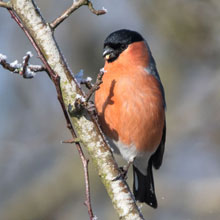 |
As I re-entered the Park I came face-to-face with a Magpie roosting on
a path-side tree. Behind it I could hear the twittering song of a
Goldfinch. Soon I had located it and taken a couple pictures. Next I
looked beyond the trees to the bushes on the hillock where I noticed a
pair of Roe Deer,
a buck (m) and doe (f), lurking in the long grass. They stood
motionless as they checked me out before slowly disappearing into the
undergrowth.
| Magpie |
Goldfinch |
Female Roe Deer |
Buck Roe Deer |
 |
 |
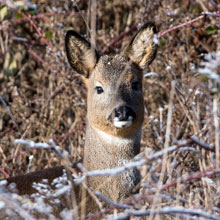 |
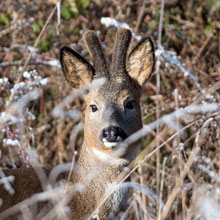 |
A Carrion Crow then flew overhead, clutching a chunk of bread in
it’s beak, followed at a higher altitude by a juvenile Cormorant
heading for the Loch. It probably got a shock when it found the water
was solid and white! Just as I neared completion of my circuit of the
park I came upon a small flock of Long-tailed Tits
feeding on tree branches over the footpath where the many walkers pass
unaware of one of the delights of nature above them. The wee acrobats
flitted from branch to branch, sometimes hanging upside down as they
searched for insects. As I snapped the Tits, a Magpie passed above them
carrying a wee dod of bread to some safe area where it could eat it
free from other birds.
| Carrion Crow |
Juvenile Cormorant |
Long - tailed Tit |
Magpie |
 |
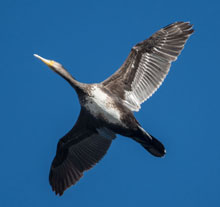 |
 |
 |
Back at the car park I scanned the water for gulls. They were mainly Black- headed, Herring and Common Gulls. I didn’t see any Lesser Black-backed Gulls ,
a regular sighting in summer months, as they are migratory, wintering
in West Africa. My final photos of the day were of a pair of mating Mute
Swans. During their courtship the birds swimming side by side and
dipping their heads alternately into the water. Then, after copulation,
both rose high in the water face to face, giving passionate grunts
before settling together, preening. I just about managed the iconic
picture of love (see “Pictures of the Week 2”, below), just
in time for St Valentine’s Day.
| Herring Gull |
Common Gull |
Black - headed Gull |
Mute Swan |
 |
 |
 |
 |
I hope I’ve conveyed an impression of the rich variety of
wildlife in the Nature Reserve at Hogganfield Park. That richness is
further enhanced from Spring to Autumn when flowers an insects appear -
but I’ll keep that for a later blog.
Pictures of the Week2:
| Kestrel |
Robin |
 |
 |
| Bullfinch |
Mute Swan |
 |
 |
Back To Top
|

